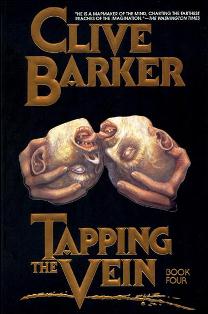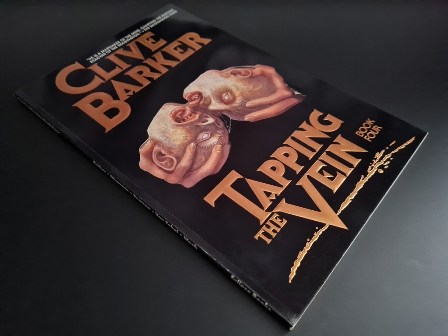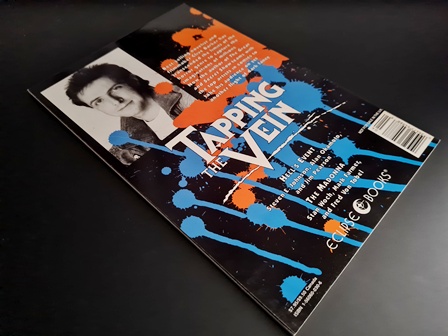
First published back in October of 1990, ‘Tapping The Vein: Book Four’ continued with the relatively successful adaptations from Clive Barker’s incredibly well received ‘Book Of Blood’ series.
This forth volume includes graphic novel adaptations of ‘Hell’s Event’ which was taken from ‘Books Of Blood: Volume Two’ (1984) and ‘The Madonna’ from ‘Books Of Blood: Volume Five’ (1985).
Hell’s Event – 26 Pages
London is teaming with a crowded mass of spectators, all lining the streets wanting to get a glimpse of the runners as they embark on this spectacular charity race. Joel Jones had had a rough night; his body is not feeling up to it. But his coach, Cameron has spurred him on. After all, the race is for charity, nothing more and nothing less. But as the race gets underway, slowly but surely, Joel’s rivals begin to fall. And elsewhere, in the quiet backstreets of London, MP Gregory Burgess is making a deal with Hell. It’s all riding on the race…Hell’s event. But whatever you do, just don’t look back…
‘Hell’s Event’ is by far and away one of Barker’s most peculiar set stories from the ‘Book Of Blood’ collection. The race itself is portrayed with a bustle of mounting excitement, with the commentators bringing out the thrills and spills of the race through London. Barker’s initially more intriguing side-story of Burgess’s mysterious meeting with Hell and the cloned familiars that accompany him, is what really starts drawing the reader into the tale. However, the storyline has much more to reveal. And after the mystery of the meeting with Hell is unveiled, so the horror-twist behind the race is thrust upon the reader, with the looming threat of Hell constantly at the runners’ heels. It’s as bizarre as it is creative. But utterly compelling throughout.
Fred Burke’s graphic novel adaptation is a strange one. Out of all of the ‘Books Of Blood’ adaptations, ‘Hell’s Event’ is perhaps the least suited to this particular format. The repetitive frames, the suggestive imagery and the limitations of word-usage really don’t fit well with the short. Indeed, much of the story is transposed in a very unnatural and clumsy way, as if it’s been chopped-up and forced into the strict regimentation of a comic strip format. The illustrations by Steve E. Johnson, Alan Okamoto and Jim Pearson are incredibly hit-and-miss. Oddly, the artwork is at its best with the more mundane frames. However, when the grotesque beasts from hell are brought into the tale, the artwork falls short quite dramatically. Looking weak and amateurish, with very little imagination put into the depiction of the strange beasts from hell, what should have been the very peaks of the story, instead flounder into abysmally cringe worthy troths.
The Madonna – 31 Pages
Jerry Coloqholin has had to pull a hell of a lot of strings to make this venture a very real possibility. If he can just get Ezra Garvey to back the redevelopment of the decaying swimming pool complex, then he could finally have a project that would work out for him. Inside the dilapidated building, Garvey’s interest in the structure and the possibilities it lends appears to be very positive. But then, whilst Jerry is elsewhere trying to gain entry into the main pool area, Garvey glimpses the fleeting figure of a naked young girl. From that moment on, an obsession with the girl takes hold of the shady businessman. But lurking in the depths of the pool resides more than just a naked young girl. Submerged in the stagnant water of the pool, strange creatures can be seen submerged in its murky depths. And a secret older than legend is waiting for Jerry’s return…
Perhaps one of the most atmospheric of Barker’s shorts, ‘The Madonna’ is a truly remarkable piece of eerie and imaginatively dark fiction. Inside the abandoned wreck of the swimming pool complex, the reader is instantly submerged in a clinging humidity that wraps itself around the story, enveloping the tale in an almost palpable atmosphere. The handful of characters that Barker brings into the tale are each well-defined and suitably open to the seductive terrors that are about to embrace them. The utterly Lovecraftian revelations are as compelling as they are momentous. And there seems almost no end to the horrors being brought to the table. That is, until Barker throws in one final twist that draws the bleak story to a final downbeat conclusion.
Fred Burke’s graphic novel adaptation of this somewhat intricate short story is an undoubted success. Burke keeps the tension up, never letting the confines of the format slow the delivery down. Furthermore, the artistically stylised structure adopted for much of the comic strip successfully magnifies the more impactful moments of the tale along its way. Stan Woch, Mark Farmer and Fred Von Tobel’s collaboration into the artwork works magnificently. The resulting imagery is fitting and suggestive, with glimpses of the horror which is purposefully never subjected to too much scrutiny; allowing for the imagination to take the reader further into the unseen elements of horror in the tale. This is certainly one of the better of the ‘Books of Blood’ adaptations, doing the original tale the justice it rightly deserves.
The graphic novel runs for a total of 64 pages.

This forth volume includes graphic novel adaptations of ‘Hell’s Event’ which was taken from ‘Books Of Blood: Volume Two’ (1984) and ‘The Madonna’ from ‘Books Of Blood: Volume Five’ (1985).
Hell’s Event – 26 Pages
London is teaming with a crowded mass of spectators, all lining the streets wanting to get a glimpse of the runners as they embark on this spectacular charity race. Joel Jones had had a rough night; his body is not feeling up to it. But his coach, Cameron has spurred him on. After all, the race is for charity, nothing more and nothing less. But as the race gets underway, slowly but surely, Joel’s rivals begin to fall. And elsewhere, in the quiet backstreets of London, MP Gregory Burgess is making a deal with Hell. It’s all riding on the race…Hell’s event. But whatever you do, just don’t look back…
‘Hell’s Event’ is by far and away one of Barker’s most peculiar set stories from the ‘Book Of Blood’ collection. The race itself is portrayed with a bustle of mounting excitement, with the commentators bringing out the thrills and spills of the race through London. Barker’s initially more intriguing side-story of Burgess’s mysterious meeting with Hell and the cloned familiars that accompany him, is what really starts drawing the reader into the tale. However, the storyline has much more to reveal. And after the mystery of the meeting with Hell is unveiled, so the horror-twist behind the race is thrust upon the reader, with the looming threat of Hell constantly at the runners’ heels. It’s as bizarre as it is creative. But utterly compelling throughout.
Fred Burke’s graphic novel adaptation is a strange one. Out of all of the ‘Books Of Blood’ adaptations, ‘Hell’s Event’ is perhaps the least suited to this particular format. The repetitive frames, the suggestive imagery and the limitations of word-usage really don’t fit well with the short. Indeed, much of the story is transposed in a very unnatural and clumsy way, as if it’s been chopped-up and forced into the strict regimentation of a comic strip format. The illustrations by Steve E. Johnson, Alan Okamoto and Jim Pearson are incredibly hit-and-miss. Oddly, the artwork is at its best with the more mundane frames. However, when the grotesque beasts from hell are brought into the tale, the artwork falls short quite dramatically. Looking weak and amateurish, with very little imagination put into the depiction of the strange beasts from hell, what should have been the very peaks of the story, instead flounder into abysmally cringe worthy troths.
The Madonna – 31 Pages
Jerry Coloqholin has had to pull a hell of a lot of strings to make this venture a very real possibility. If he can just get Ezra Garvey to back the redevelopment of the decaying swimming pool complex, then he could finally have a project that would work out for him. Inside the dilapidated building, Garvey’s interest in the structure and the possibilities it lends appears to be very positive. But then, whilst Jerry is elsewhere trying to gain entry into the main pool area, Garvey glimpses the fleeting figure of a naked young girl. From that moment on, an obsession with the girl takes hold of the shady businessman. But lurking in the depths of the pool resides more than just a naked young girl. Submerged in the stagnant water of the pool, strange creatures can be seen submerged in its murky depths. And a secret older than legend is waiting for Jerry’s return…
Perhaps one of the most atmospheric of Barker’s shorts, ‘The Madonna’ is a truly remarkable piece of eerie and imaginatively dark fiction. Inside the abandoned wreck of the swimming pool complex, the reader is instantly submerged in a clinging humidity that wraps itself around the story, enveloping the tale in an almost palpable atmosphere. The handful of characters that Barker brings into the tale are each well-defined and suitably open to the seductive terrors that are about to embrace them. The utterly Lovecraftian revelations are as compelling as they are momentous. And there seems almost no end to the horrors being brought to the table. That is, until Barker throws in one final twist that draws the bleak story to a final downbeat conclusion.
Fred Burke’s graphic novel adaptation of this somewhat intricate short story is an undoubted success. Burke keeps the tension up, never letting the confines of the format slow the delivery down. Furthermore, the artistically stylised structure adopted for much of the comic strip successfully magnifies the more impactful moments of the tale along its way. Stan Woch, Mark Farmer and Fred Von Tobel’s collaboration into the artwork works magnificently. The resulting imagery is fitting and suggestive, with glimpses of the horror which is purposefully never subjected to too much scrutiny; allowing for the imagination to take the reader further into the unseen elements of horror in the tale. This is certainly one of the better of the ‘Books of Blood’ adaptations, doing the original tale the justice it rightly deserves.
The graphic novel runs for a total of 64 pages.

© DLS Reviews
Other ‘Tapping The Vein’ instalments:
- ‘Tapping The Vein: Book One’ (1989)
- ‘Tapping The Vein: Book Two’ (1989)
- ‘Tapping The Vein: Book Three’ (1990)
- ‘Tapping The Vein: Book Four’ (1990)
- ‘Tapping The Vein: Book Five’ (1992)










